
Structuralists say structures can be uncovered anywhere—from human behavior to star clusters and snowflakes to mathematics. In fact, structuralism offers a kind of mathematization of the entirety of nature, even systems that were once considered too complicated to model, such as language or human behavior. Structuralism began with thinkers like Saussure and Levi-Strauss, who were interested in linguistics and anthropology. Let’s take a look at the history of structuralism!
Structuralism as a Method

Ferdinand de Saussure was the first to invent and apply the structuralist approach to the study of language. Structuralism implies a systematic and patterned description of events, in this case, of language. The structuralist approach can be understood as standing in more or less direct opposition to a historical approach, which points to the origins, processual elements, and contingent moments in the development and formation of otherwise coherent and stable linguistic “structures.”
From the side of anthropology, Claude Levi-Strauss had opened up his own line of structuralist methodologies. Analogously, Levi-Strauss believed that structures can be uncovered in the world, specifically in the study of human behavior. One of the interesting and controversial claims made by structuralists (and countered by post-structuralists) is that the human subject itself is, at least in principle, another calculable structure.
However, many scholars see the anthropological direction as another application of linguistic structuralism. Linguistics is thought to be the essence of structuralism, whereas anthropology is only one of its possible applications. Since language is considered the central institution in any social formation, it seems to carry the essential foundation of the structuralist approach. Hence, structural linguistics is privileged over structural anthropology.
Structuralist linguistics has two main branches: European and American. Some scholars argue that a certain variety of structuralism originated independently in America before the import of European structuralist linguistics, preparing the ground for its enthusiastic reception and further diffusion.
The Geneticist vs. the Universalist Vision of Language

A renewed philosophical interest in the workings of language around the 1920s marks the beginning of linguistic structuralism in Europe and America. The universal theory of language made its first several appearances around this time. The universalist theory of structuralist linguistics directly opposes the historicist or geneticist conception of language.
Unlike the mainstream methodologies in the study of language, Saussure was most interested in the persistent elements of language that remained invariant for some limited time per historical period. Saussure was interested in language’s spatial, unchanging, mathematical features rather than the temporal and transitional moments when new words, colloquial manners of expression, and various tropes facilitate change and transformation.
Saussure termed the distinction between language’s changing and unchanging elements as diachronic and synchronic, respectively. In other words, the static, synchronic features of language interest the universalist, and the dynamic, diachronic ones fascinate the geneticist. Unlike the American school of structuralism, which sees grammar as the central feature of language, Saussure tended to focus on the phonetic structures in language.
Interestingly enough, Saussure’s magnum opus, Course in General Linguistics, does not mention the word “structure” once. Instead, Saussure uses the term “system.” Linguistic systems are governed by simultaneity rather than succession. A structuralist is, therefore, interested in the fixed relations between things rather than the series of their different states. Needless to say, the synchronic view still dominates in modern academia, even though diachronic approaches are gaining some traction.
The Saussurean system of language is often interpreted as a linguistic reflection of the collective unconscious of any (and every) given society.
Structuralism, Phenomenology, and Gestalt Psychology

A distinction that runs parallel to the categories of synchronic and diachronic is the difference between the notions of langue (language) and parole (speech). The first refers to the general abstraction, the entire calculus of language in general, whereas the latter refers to particular linguistic speech acts or ‘events of enunciation’; concrete occurrences.
Structuralism significantly impacted Gestalt psychology and phenomenology. As we already mentioned, Structuralism had much in common with phenomenology in its earliest stages, which aimed to construct a well-founded scientific system for the language, world, and subject.
Like structuralism, phenomenology was interested in elements, phenomena, or conscious experiences that remained invariant throughout the stream of consciousness. It sought to explain an event by abstracting away from its changing and turbulent elements to uncover the eidetic essences entrenched in the world—entities that seem similar to the structuralist notion of a system.
Gestalt in Gestalt psychology means pattern, which is analogous to structure. Once more, the similarity with structure is brought forward. Like phenomenology and structuralism, gestalt psychology seeks to uncover the structures, patterns, and essences of human experience. All three methodologies have a scientific bent, assuming the world is fundamentally structured and rational. However, these assumptions did not carry over into the worldviews of their post-structuralist descendants.
All three paradigms seem to account for an interpretation and epistemic commitment to the idea that either the world is structured according to determinate elements or the human mind inevitably imposes a structure of such relations. According to Gestalt Psychology, phenomenology, and structuralism, the world is fundamentally a system of functional relationships, unlike some large three-dimensional containers of objects and facts.
Literature and Structuralism

The most notorious and provocative application of structuralism occurred in literature. If there ever was a field of knowledge that would resist homogenization, systematization, and systematic modeling, it would have to be prose, fiction, poetry, and literary language as such. Literature is a medium that seeks to be maximally heterogeneous; it is the region of pure novelty. Literature deals with monsters, exceptions, and unique and irreproducible situations. It deals with life genuinely and almost without any abstraction.
Poetry seeks to express the unsayable things that refuse domestication, systematization, and ordering. Literature is the art of self-negation; true lyricism is always that which refuses itself, its identity, and its structure. It is far from surprising that such a “discipline” would be the most aversive and rebellious vis-à-vis the mechanistic, linguistic apparatus of structuralism.
When content becomes systematic, it tends to lose the power of self-expression. At the expense of rigor, a human element seems to sacrifice itself to structure. Structuralism tends to treat the individual, the human self, as a mere variable within a function. The self becomes substitutable and generic. In this process of formalization, the phenomenal richness of life seems to disappear entirely. Literature cannot allow this.
Literature remains nonetheless diachronic as it concerns itself with the concrete events of enunciation. Literature is precisely concerned with the astructural element of parole. It accounts for the milieu and the material, social, and cultural conditions for speech. Without that, we must make these explicit the way anthropology does.
A Face Drawn in the Sand

Some interesting political implications flow naturally out of structuralism’s epistemic commitments. One such effect is the discipline’s disappearance of the subject, which disappears like “a face drawn in sand,” as Foucault famously said. This undermines the notion of an autonomous individual, causing the primary conception of human nature to fall apart.
Instead, the “subject” is seen as a placeholder or variable within the function of discourse. Thus, the fundamental distinction between the subject and object made by Descartes, Kant, and other classical thinkers collapses, marking another significant transformation in the history of Western reason.
Many structuralists’ deterministic views offer a novel reading of the notion of freedom. Freedom is no longer simply being free of literal obstacles and constraints. Liberation becomes complicated as we realize that our subjectivity is a product of otherwise quite strange and alien structures. Often, anonymous cultural webs of discourse are like a net thrown over the subject, and the subject is thrown into them without consciousness, let alone willing or reflective consent.
Structuralist anti-humanism should not be confused with ethical and political anti-humanism. Both structuralist and post-structuralist strategies of exposing the liberal subject as an institutional/discursive construct aim to uncover a more fundamental “humanism” or ethics of the self that refuses to be exploited by naive notions of freedom, justice, and humanity.









